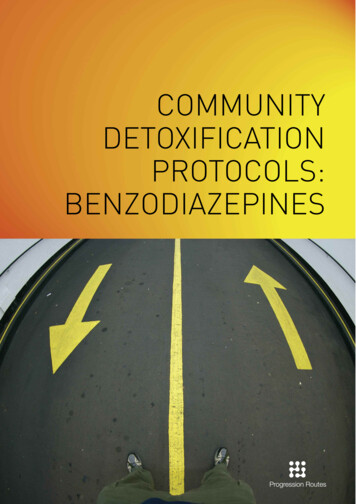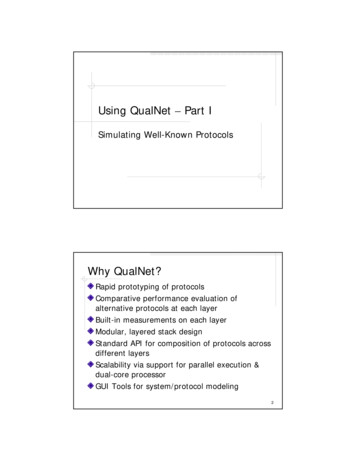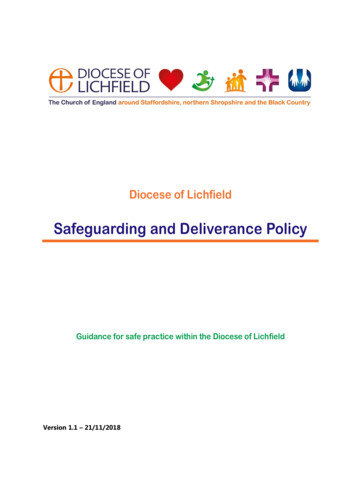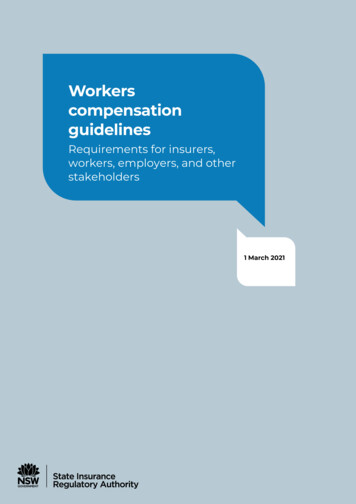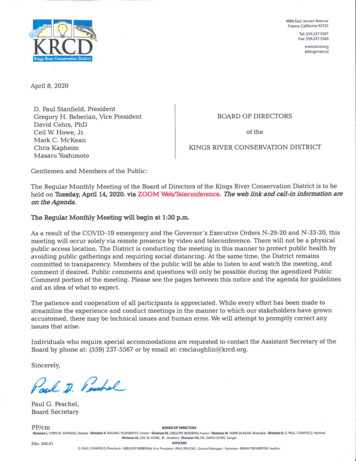
Transcription
Guidelines and Protocols ofDiabetes Emergencies
2
Guidelines and Protocols ofDiabetes Emergencies“Pediatrics”3
Guidelines for Diagnosis & Management of Diabetic Ketoacidosis (DKA) in Childrenunder 14 years of Age and/or 50kg weightIntroduction:A team from three subspecialties has formulated these guidelines for the diagnosis and management of DKAin children and young people under the age of 14 years: pediatric endocrinology, pediatric emergency careand pediatric intensive care.It is based on most recent international evidence and guidelines, and structured to be as simple and as safeas possible in the light of evidence based practices.However, no guidelines can be considered entirely safe and complications may still arise, as the pathophysiologyof cerebral edema is still poorly understood. Some patients may need slightly modified approach based onindividualized and justified need but these guidelines should be generally implemented at all hospitals.When to suspect DKA:SuspectDKAYou should suspect DKA when having a constellation of the following history and clinical signsHistoryClinical FeaturesPolyuriaPolydipsiaWeight lossTirednessDehydrationTachypnea; deep (Kussmaul) respiration Breath thatsmell like acetone (ketone) Nausea, vomiting, andabdominal pain Confusion, lethargy, drowsinessDefinition of DKA:By definition, DKA is present when a type I (or sometimes type II) diabetic patient present with hyperglycemia,glycosuria, metabolic acidosis and ketonuria. Please confirm by the following criteria:ConfirmDKAThe biochemical criteriaHyperglycemia (BG 11mmol/L 200mg/dL) Venous pH 7.3or bicarbonate 15mmol/LKetonemia and/or ketonuriaExclude Hyperosmolar HyperglycemicState (HHS) (see appendix I)Consider other differential diagnoses(see appendix II)Caveat 1: Children and adolescents with known diabetes may rarely develop DKA if they did not stop insulinand have normal Blood Glucose levels.4
Management in Emergency Room or Urgent Care Area:The most important aspect of 1st hour management is maintaining the delicate balance between stabilizingthe patient and adhering to conservative fluid replacement. The plan can be summarized as follows:1st Hour Management ER/Urgent CareFor all DKA patients Connect to cardiorespiratory monitor & pulse oximeterAnalyze ECG to evaluate for signs of hyper or hypokalemia.Support Airway, Breathing, and Circulation as needed (as per PALS recommendations).Airway support (no elective intubation for significant tachypnea, consult expert- seeappendix III)Give 100% O2 by face maskInsert two IV cannulasInsert nasogastric tube if indicated (avoid in obtunded patients if the airway not protectedrisk of aspiration)Measure body weight (BW) and estimate for unstable patient (Broselow tape or growth chart)Send urgent labs: Blood glucose, blood gases (capillary or venous), urea & creatinine,electrolytes, serum osmolality, calcium, magnesium, phosphorus, albumin, CBCs withdifferential.Serum ß Hydroxy Butyrate concentrate (if available), urine analysis and urine ketones.Blood culture, urine culture, throat swab, CXR for suspected infection (as clinically indicated). Start fluid replacement as follow: Fluid Management in 1st hourPatient could present in shock or only dehydrated but with stable hemodynamics.Table below summarize the management of both scenariosDehydrated, not in shock: Estimatethe severity of DKAIf patient is in clinical shock:(weak peripheral pulses, prolongedcapillary refill 3 seconds, reducedconscious level)Mild: venous pH 7.3 or bicarbonate 15mmol/LModerate: pH 7.2 or bicarbonate 10mmol/LSevere: pH 7.1 or bicarbonate 5mmol/LShock with hypotension (late sign):10 ml/kg 0.9 Saline bolus over 5-10minutes. Repeat x3 till normal BP(consult expert)Start IV 0.9% Saline at:5 ml/kg/h for mild/moderate DKA 7 ml/kg/h for severe DKAShock, not hypotensive(compensated):10 ml/kg 0.9 Saline over 1 hourCaveat 2: Always discuss the management with most senior physician in your area.Careful with severe cases that can present in obtunded state and consider signs & management of CerebralEdema upon initial presentation (see details on page 3)5
Management Plan after the 1-2 hoursThe three fundamental elements of DKA management are rehydration, insulin and electrolytes replacementand close clinical and laboratory monitoring for potential complications and they are summarized as follows:Management Post 1-2 hoursIn highly monitored unitFluid calculation principlesIV Maintenance deficitMaintenance calculation:100 ml/kg for the first 10 kg 50 ml/kg for the next 10 kg 20 ml/kg for the rest BWDeficit calculation:5% for mild to moderateDKA 10% for severe DKACorrect slowly over 48hours Start 0.9% Saline(with KCl)Potassium: 40 mEq/L KCl(after 1st void & if K level 5.5)InsulinMonitoring (& record)Mix 50 unit of soluble insulin(e.g. Regular) in 50 ml 0.9%saline bag (1 ml 1 unit)(50 units in 500 ml secondoption, 10 ml 1 unit)Hourly: Vital Signs Capillaryblood glucose (bed side),Neurological status (pupils &Glasgow Coma Scale (GCS),Fluid intake & output Every2-4 hours:Blood gases (venous orcapillary)Start after 1-2 hour fromfluid initiationStarting dose:0.05-0.1 unit/kg/hr0.05 dose for kids:-Younger than 5 years-Newly diagnosed-rapid drop of Blood Glucose 100mg/dl/hrEvery 4 hours:BG, electrolytes, urea,creatinine, phosphorus,calcium, magnesiumCaveat 3: Fluid volume from insulin bag (when using 500 ml bag for mixing) to be included in the totalrehydration fluid. Remove from the total rehydration fluid the fluid boluses that are more than 20ml/kg only.No routine replacement of ongoing losses. Only consider when fluid balance remains negative (check Q 4hours) Always request fluid early (expect 1hour delay)To minimize calculation burden, errors, and confusion we recommend the followingsimplified and slightly moreconservative total fluid calculation for first 48 hrs after DKA presentationSimplified calculated rate 15 kg16 to 40 kg 40by weightMaintenance deficit5 ml/kg/hr4 ml/kg/hr3 ml/kg/hrNB. All fluids given during resuscitation should be documented carefully, particularly the fluid given in ER.Special lab consideration In newly diagnosed diabetic:HbA1C, insulin antibodies, glutamic acid decarboxylase antibodies, thyroid function and thyroid antibodies (ifavailable in your facility laboratory).The following has been associated with risk of cerebral edema, please avoid themDO NOTDO List6 DO NOT give insulin bolusDO NOT give IV sodium bicarbonate (except in life-threatening hyperkalemia)DO NOT give fluid boluses for DKA not in shockDO NOT give hypotonic fluid (0.45%, 0.22%) for rehydrationDO NOT give more than 10 ml/kg fluid bolus each time if in shockDO NOT exceed 1.5-2 maintenance/day as a general rule
Goals of Therapy‣‣‣‣Correct dehydration slowly (over 48 hrs)Correct acidosis and reverse ketosis (don’t interrupt insulin if acidosis is not resolving)Restoring blood glucose (BG) to near normalMonitor for DKA complications: Manage the patient in advance care unit (PICU, High Dependency Unit, ER) Keep the nurse to patient ratio 1:1 for severe DKA (assign nurse with advanced care skills) Admission to the ward is not recommended as it carry with it a significant risk of inadequatemonitoring and possible life threatening errors (potassium errors, hypoglycemia etc)Identify and treat any precipitating event: Fever could be due to presence of infection, please send cultures and start antibiotics.‣Higher risk "patients" who need rigorous monitoring even when managed in PICU are kids with:‣‣‣‣Severe DKA with pH 7.1Severe dehydration with shockDepressed level of consciousnessThose who are at increased risk for cerebral edema 5 years of age (and more risk in 2 years of age) Lower than expected pCO2 for the degree of metabolic acidosis High urea nitrogen upon presentationAdjustment and Trouble Shooting‣‣‣‣‣When blood glucose (BG) drops to 14-17 mmol/l (250-300 mg/dl) add Dextrose 5% to 0.9% SalineWhen BG drop to 8 mmol/l ( 140-150 mg/dl) add D10% to 0.9% SalineWith rapid fall of glucose ( 100 mg per hour): Add D10% and can increase to max D12.5% if acidosisis not improving (may decrease insulin to 0.05 u/kg/hr or even down to 0.03 u/kg/hr if acidosis isimproving)Hypoglycemic attack 4 mmol/ ( 72mg/dl): Give 2-5 ml/kg D10% bolus, hold insulin for 15-30 min thenrepeat Blood Glucose.Potassium AdjustmentPotassium 5.5 mmol/lPotassium 3.5 mmol/lPotassium 2.5 mmol/lHold Potassium, repeat level in 2 hrsIncrease KCl to 60 mmol/l (need good peripheral IV or Central Line)Monitored administration of extra 1 mmol/kg KCL over 2 hoursPhosphorus Replacement (based on level or symptomatic hypophosphatemia)Phosphorus 0.5 mmol/l (1.5 mg/dl): Replace ½ of KCl with Potassium PhosphateIf acidosis is not correcting (assess bicarbonate change more than pH) consider: Inadequate fluid resuscitationWrong insulin dose or preparationHyperchloremic metabolic acidosisSepsis (usually with lactic acidosis)‣‣‣‣Recalculate and assess intake/output every 4hRecheck all preparationMeasure chloride and anion gap* (see legend)Look for signs, measure lactate*Anion Gap calculation: Na – (Cl HCO3) 12 2 (normal).7
DKA Resolution and Shifting to Subcutaneous InsulinINTRODUCTION OF ORAL FLUID and TRANSITION OF SUBCUTENEOUS INSULIN:Oral fluids should be introduced when substantial clinical improvement has occurred (mild acidosis/ketosismay still be present) and the patient indicates a desire to eat.The indication to start subcutaneous insulin Patient is fully conscious and willing to eat with no nausea or vomiting Ketoacidosis has almost resolved (serum bicarbonate 15 mEq/l twice) Venous pH 7.3 Ketone in urine may still be positiveFluid management:‣ When oral fluid is tolerated, intravenous fluid should be reduced and oral fluid intake should be includedin total rehydration fluid calculation‣ Start special diabetes diet after stopping insulin infusion (at least 30 minutes after subcutaneous insulininjection)Insulin Management:‣ The most convenient time to change to subcutaneous insulin is just before a mealtime.‣ To prevent rebound hyperglycemia, the first subcutaneous injection should be given 15–30 min withrapid- acting insulin (insulin aspart) or 1–2 h with regular insulin, before discontinuing the insulin infusion.Insulin Dose:‣ If patient is known DM1 on appropriate treatment, then to resume patient previous doses‣ If new DM1 with DKA start 0.75 unit/Kg /day, as Basal Bolus regime divided to: 30-40 % long acting - Basal (e.g. levemir or Glargine or Degludec) 60- 70 % as rapid acting insulin pre or post meals(use different arm when the two given in the same time)Use glargine (lantus) as long acting insulin If age above 3 years and levemir as basal insulin if age 3 yrs Rapidacting insulin analogue like aspart , lisro , Humalog can be given 15-30 minutes before stopping insulin infusion‣‣‣‣Monitor blood sugar by gluco-check 6 times daily (Before meals and 2 hours post-meals ) and adjustthe dose of insulin according to blood sugar result.Consult pediatric endocrinologist if available.Diabetic educator and dietitian should be involved early to educate patient and care giverIf insulin analogue is not available, you might use two dose insulin regimen as shown in the next table:Two doses insulin regimens for newly diagnosed diabetes after resolution of DKATotal dailyPre-pubertal: 0.5-1.0 unit/kgdosePubertal: 1.0-1.2 unit/kgTwo-thirds of total daily dose (TDD)Before‣ One-third rapid acting insulinbreakfast‣ Two third intermediate-acting insulin (e.g. NPH)One third of TDDBefore dinner ‣ One-third rapid acting & Two third intermediate-acting insulin OR‣ One-half rapid acting & one-half intermediate-acting insulin (e.g. NPH)Monitor blood sugar by gluco-check 4 times Daily ( before meals and at bed time)8
Serious DKA Complications & PrecautionsDKA Complications & Cerebral Edema ManagementFatal ComplicationsCerebral Edema Hyper/hypokalemiaOther Common rationpneumoniaHyperchloremicacidosisCerebral Edema Risk FactorsUncontrollable‣‣‣‣‣‣Younger age ( 5 years)New onset diabetesLonger duration of symptomsSevere hypocapnia (more thanexpected for acidosis)Increased serum urea nitrogenSevere acidosisControllable‣‣‣‣‣‣IV Bicarbonate treatment for correction of acidosisAdministration of insulin in the first hour of fluidtreatment (bolus or infusion)Greater volumes of fluid given in the first 4hA marked early decrease in effective serumosmolality ( 5 mOsm/hr)*Serum sodium (corrected)** dropping or not risingwith treatmentHighly suspiciousCerebral EdemaSigns & Symptoms and �‣‣‣Severe headacheAgitation or irritabilityUnexpected fall in heart rateIncreased blood pressureDecreased level ofconsciousnessManagementInform the Most Responsible Physician/consultant Treatimmediately with the most readily available of:‣ Mannitol 20% (0.5-1 g/kg over 10-15 minutes) or‣ Hypertonic saline 3% (3-5 ml/kg over 10-15 min) Dropfluid rate by one third of totalElevate the head of the bed to 30ºLife Threatening r deterioration in level of consciousnessAbnormalities of breathing pattern (e.g. breathing pauses)Oculomotor palsiesUrgentAbnormal posturingPupillary inequality or dilatationManagement(Repeat all above steps and consider)Mannitol or Hypertonic saline (Repeat in 30 min to 2 hrs if no initial response)Secure Airway (by experienced staff)Do not sedate or suppress patient hyperventilation without control breathingControl ventilation (match patient hyperventilation then increase pCO2 slowly to 35 mmHg)CT when stable (to exclude: hemorrhage, thrombosis)Neurosurgical consultation for other surgical options*Effective Osmolality: 2 Na Glucose (glucose value in mmol/L)**Corrected Na measured Na 2 [(plasma glucose-100/100)] mg/dL9
AppendicesAppendix IHyperosmolar Hyperglycemic State (HHS) DiagnosisHHSUsually occurs in Type 2 diabetesMarked hyperglycaemia(33.3 mmol/L or more) (600 mg/dl)No significant hyperketonemia or acidosis(pH 7.3, bicarbonate 15 mmol/L)Osmolality usually 320 mosmol/kg or moreHigh mortality rateMore hypovolemia, need faster rehydrationInsulin replacement is second line therapyDKAUsually more in Type 1 diabetesHyperglycemia( 11 mmol/L or more) ( 200 mg/dl)Significant ketonemia and acidosis(pH 7.3 or bicarbonate 15mmol/L)Osmolality variable but usually 320 mosmol/kgLow mortality rateDehydrated but need slow rehydrationInsulin replacement is the mainstay of therapyAppendix IIDifferential Diagnosis of DKA (hyperglycemia, acidosis, and ketosis)DiagnosisSalicylate IntoxicationMetabolic Diseases (Inborn Error ofMetabolism)Severe stress with starvation (?Sepsis)Other distinguishing featuresHistory, Salicylate level if suspiciousFamily history, other features of disease (consult expert)Examine the patient, features of sepsis, disease progressAppendix IIIAirway considerations Secure the airway in:Comatose patient (GCS 8)Abnormal breathingBy expert physicianHyperventilate (same patient CO2 & correct slowly)NG insertion:Do not induce vomiting if patient can’t protect airway10
Initial management of Hyperosmolar Hyperglycemic State (HHS)Definition: HypovolemiaMarked hyperglycemia of 600 mg/dl (33.3 mmol/L) or moreNo significant hyperketonemia or acidosis (pH 7.3, bicarbonate 15 mmol/L)Osmolality usually 320 mOsmol/kg or moreAltered consciousness or seizureUsually occurs in Type 2 diabetes (improper hydration) and has a high mortality rate.Goals of treatment: Treat the underlying cause and to gradually and safely: Normalize the osmolalityReplace fluid and electrolyte lossesNormalize blood glucosePrevention of complications: arterial or venous thrombosis cerebral edema central pontine myelinolysisFluid therapy: The rate of fluid replacement should be more rapid than is recommended for DKA. The goalis to expand the intra and extravascular volume and restore normal renal perfusion. Give an initial bolus should be of 20 mL/kg of isotonic saline (0.9% saline)Assume a fluid deficit of approximately 12–15% of body weight.Additional fluid boluses should be given, if necessary, to restore peripheral perfusion.Thereafter, 0.45–0.9% saline with potassium (like in DKA) should be administered to replace the deficitover 24–48 hours.Unlike DKA, replacement of urinary losses is recommended (0.45% or 0.9% saline).The goal is to promote a gradual decline in serum sodium concentration and osmolality. Measure serum sodium concentrations every 2-4 hours Adjusted sodium concentration in fluids to promote a gradual decline in corrected serum sodiumconcentration (0.5 mmol/L per hour). Failure of the corrected serum sodium to decline with treatment, consider hemodialysis Rapid fall in serum glucose ( 5 mmol/l per hour) consider adding 5% glucose to the fluid.Insulin therapy Blood glucose levels will fall with fluid alone and insulin is NOT required early in treatment. Insulin administration should be initiated when serum glucose concentration is no longer declining at arate of at least 3 mmol/l per hour with fluid administration alone11
Order Sheet for Pediatric DKA Patients ( 14 years and/or 50 kg body weight)Date: Time: (military: 24 hour format)Admit the patient to:Patient Weight: KgPICUHDULength/Height: cmUnder the care of Dr.Noted byLaboratory monitoringNoted byHourlyObtain Patient Weightcapillary blood glucoseConnect to cardiorespiratory monitorEvery 2 hoursConnect to pulse oximeterCapillary or venous bloodgasesRecord vital signs hourlyRecord neurology assessment hourly (pupils size, reactivity, GCS)Serum electrolytesNothing by mouth (NPO)Every 4 hoursInsert two IV cannulasSerum electrolytesStrict intake and output and record hourlyCalcium, Phosphorus,Magnesium,Urea, CreatinineInsert Foley›s catheter (only if indicated)Check Urine for ketones (bedside check)Upon AdmissionAdditional Investigations:CBC-differentialHbA1CUrine analysisOther Blood culture, Urine cultureChest XrayFluid in the first hour:Shock & hypotensive patient: StartNoted by ml (10 ml/kg) %0.9 Saline IV bolus over 10-5 minutesStill hypotensive: Repeat bolus ml IV (10 ml/kg) over 10-5 minutesCall physician to the bedside if patient is unstableShock, not hypotensive: Start ml (10 ml/kg) %0.9 Saline IV over one hour.Not in shock: Start ml IV infusion %0.9 saline over 1 hourFor severe DKA (bicarbonate 7 :)5 ml/kg and for mild to moderate DKA (bicarbonate 5 :)5ml/kgFluid after 2-1 hours:Calculation formulaNoted by 15 kg weight: 5 ml/kg/hr,Start IV %0.9 saline at ml/hourPotassium Chloride Add 40 mmol/L (20 mmol to 500 normal saline bag)Add only if patient is passing urine and K level is 5.5 mmol/L16 to 40 kg: 4 ml/kg/hr 40 kg: 3 ml/kg/hrAdd Dextrose %5 to %0.9 Saline fluid when blood glucose drops to 250 mg/dl (14 mmol/L)Add Dextrose %10 to %0.9 Saline fluid when blood glucose drop to 150-140 mg/dl (8 mmol/L)Insulin Infusion: DO NOT GIVE BOLUS and Start after 2-1 hour from fluid initiationNoted byMix 50 unit of Regular insulin in 50 ml %0.9 saline Starting dose: ml/hour ( 0.1 unit/kg/hr)(0.1 ml/kg/hr 0.1 unit/kg/hr)Or: Mix 50 unit of Regular insulin in 500 ml %0.9 saline Starting dose: ml/hour ( 0.1 unit/kg/hr)(1 ml/kg/hr 0.1 unit/kg/hr)Use 0.05 unit/kg/hr dose for high risk kids Younger than 5 years, Newly diagnosed or with Rapid drop of BG ( 100mg/dl/hr)Antimicrobials (consider for fever, sepsis):Physician Name & Signature: 12Noted byNurse Name & signature:
Appendix V:Glasgow Coma Scale (Maximum score 15, minimum score 3)Best Motor Response1 none2 extensor response to pain3 abnormal flexion to pain4 withdraws from pain5 localizes pain6 responds to commandsEye Opening1 none2 to pain3 to speech4 spontaneousBest Verbal Response1 none2 incomprehensible sounds3 inappropriate words4 appropriate words but confused5 fully orientatedModification of verbal response score for children5-2 years1 none2 grunts3 cries or screams4 mono-syllables5 words of any sort 2 years1 none2 grunts3 inappropriate crying or unstimulated screaming4 cries only5 appropriate non-verbal responses(coos, smiles, cries)Appendix VI:Definition of hypotension in pediatrics (PALS 2015)Neonate (up to 28 days of age)Infants (12-1 months)Children from 1 to 10 yearsChildren 10 years of ageSystolic BP 60 70 70 (age in years X 2) 9013
Algorithm for the Management of DKA in ChildrenConfirm DKA DiagnosisHyperglycemia (BG 11mmol/L 200mg/dL) Venous pH 7.3 and/or bicarbonate 15mmol/L KetonuriaDKA in Shock1st Hour ManagementNotify PICU, Alert seniorprimary physicianAirway: No elective intubation/call expertBreathing: %100 O2 byFace Mask, Check O2 SatCirculation: 2 IV cannulas,cardiac monitorHypotensive: 10 ml/kg NSbolus over 10-5 min Repeatif hypotensive (x 3) - considerinotropesShock with normal BP: 10ml/kg NS over 1 hrDKA not in ShockAssess SeverityUrgent Labs Blood glucoseBlood gases electrolytesCa, Magnesium PhosphorusUrea, CreatinineMild: pH 7.3 or bicarbonate 15mmol/LModerate: pH 7.2 orbicarbonate 10mmol/LSevere: pH 7.1 or bicarbonate 5mmol/L1st hour fluid: 0.9% saline7 ml/kg/h for severe DKA5 ml/kg/h for mild/moderateDKAAlways admit high risk patients (e.g. severe DKA, young 2 years old, newlydiagnosed diabetes) to highly monitored area (like PICU, high dependency unit) withnurse to patient ratio of 1:1Post 1st Hour ManagementInsulin (DO NOT GIVEBOLUS)Mix 50 unit of soluble insulin(Regular) in 50 ml %0.9 saline(Alternatively: mix 50 unit in500 ml %0.9 saline bag, Insulinfluid volume to be included inthe total rehydration calculationwhen using 500 ml bag)Starting dose: 0.1-0.05 unit/kg/hr0.05 dose for kids:-Younger than 5 years-Newly diagnosed-Rapid drop of BG ( 100mg/dl/hr)-Recently received insulininjectionStart after 2-1 hour fromstarting rehydration fluid14Simplified calculated rate by weight 15 kg5 ml/kg/hrMonitoringRemove fluidHourly: Vital Signsboluses of 20Blood glucose, Neurological16 to 40 4 ml/kg/hrml/kg from thestatus (pupils & GCS),total replacement 40 kg3 ml/kg/hrFluid intake & outputEvery 4-2 hours:Fluid calculation principlesBlood gases (venous orcapillary)IV Maintenance deficitEvery 4 hours:Correct deficit slowly over 48 hoursElectrolytes, urea & creatinine,Deficit calculation: %10 for severe DKAphosphorus, calcium,%5 for mild to moderate DKAmagnesium Other labs:Start %0.9 Saline (with KCl)CBC & differential, BloodPotassium: 40 mEq/L KClculture, urine culture (with(add after 1st void & only if K level 5.5)fever)No routine replacement of ongoingFor new onset diabetes:losses but avoid negative balancesee guidelines(reassess every 4 hrs)
Adjustment and Troubleshooting‣ BG 14-17 mmol/l (250-300 mg/dl) Add Dextrose 5% to 0.9% Saline‣ BG 8 mmol/l ( 140-150 mg/dl) Change D5% to D10% to 0.9% Saline‣ Rapid fall of glucose ( 100 mg/dl per hour): May drop insulin to 0.05 u/kg/hr Or change D5% to D10% if acidosis is not improving Try not to wean insulin dose to 0.05 u/kg/hr if acidosis still present‣ Hypoglycemic attack ( 4 mmol) (72 mg/dl) 2-5 ml/kg D10% bolus, hold insulin temporarily (15-30 min, repeat BG and restart)‣ Potassium 5.5 mmol/l (not hemolyzed) Hold Potassium‣ Potassium 3.5 mmol/L Increase KCl to 60 mmol/l (need good IV)‣ Phosphorus 0.5 mmol/l (1.5 mg/dl) Replace ½ of KCl with K Phos‣ Acidosis not improving trouble shooting ‣ See attached guidelines‣ Always prepare next fluid to be used in advance (expect 1 hour delay)Monitor for ComplicationsCerebral edema: Neuro exam/hourly Hypokalemia: ECG. electrolytesAspiration pneumonia: avoid NG if airway protection is questionableEarly Signs of Cerebral EdemaSevere headache Agitation or irritabilityUnexpected fall in heart rateIncreased blood pressure Decreased level of consciousnessMannitol or 3% Saline standby(see attached guidelines for details)DKA ResolutionClinically well, HCO3 15Tolerating oral intakeSwitch to oral intake (special diet)SC insulin as per endocrinologist order or per attached guidelines (appendix III) DO NOT give insulin bolusgive IV sodium bicarbonate (use only in life-threatening hyperkalemia) givefluid boluses for DKA not in shockgive hypotonic fluid (0.45%, 0.22%) for rehydration give more than 10 ml/kg offluid each time if in shock give more than 1.5-2 maintenance per day15
Management of Hypoglycemia in Infant and Children below 14 YearsDEFINITION: For infants and children: plasma glucose 3.3 mmol/L or 60 mg/dl measured by accurate laboratorymethod For neonate: refer to the neonatal hypoglycemia management protocol.PRESENTATION In newborn; apnea, cyanosis, poor feeding, sweating tremors, jitteriness, irritability, convulsion, coma. Infant and children; Irritability, dizziness, blurred vision, difficulty speech, headache, confusion, feelingfaint, personality changes, Palpitations. Hunger, Nausea Sweating, Anxiety Tremulousness NervousnessAtaxia, drowsiness, convulsion, coma.DIAGNOSIS: Reliable blood sugar estimation during symptoms.ASSESSMENTHistory: Neonate; prematurity, IUGR, maternal diabetes, perinatal stress e.g. birth asphyxia, sepsis, shock, fastinghypoglycemia or hypoglycemia after meal (hyperinsulinemia) Diabetes Mellitus, renal insufficiency/failure, hepatic cirrhosis/failure, other endocrine diseases, or recentsurgery Drug Hx : Insulin usage or ingestion of an oral hypoglycemic agent, toxic ingestion, new medications The social history may include intake and nutritional deficiency Review systems for: weight reduction, nausea, vomiting, headache, etc. . Look for other symptoms suggesting infectionExamination: Physical findings are nonspecific in hypoglycemia and generally are related to the central and autonomicnervous systems. Height, weight (thin stature- ketotic hypoglycemia. Assess vital signs for hypothermia, tachypnea, tachycardia, hypertension, and bradycardia (neonates) The head, eyes, ears, nose, and throat examination may indicate blurred vision, pupils normal to fixedand dilated, icterus (usually cholestatic due to hepatic disease) Cardiovascular disturbances may include tachycardia (bradycardia in neonates), hypertension orhypotension, and dysrhythmias. Midline congenital anomalies : Ambiguous genitalia micropenis, facial anomalies, cleft palate, centralincisor, nystagmus, etc. Respiratory disturbances may include dyspnea, tachypnea, GI disturbances may include nausea and vomiting, dyspepsia, and abdominal cramping Hepatomegaly glycogen storage disease. Any abdominal mas Skin may be diaphoretic and warm or show signs of dehydration with decrease in turgor, hyperpigmentations Neurologic conditions include coma, confusion, fatigue, loss of coordination, tremors, convulsions, anddiplopia and Cataract in case of galactocaemia.16
MANAGEMENT PLAN:Hypoglycemia Bloodsugar 3.3 mmol/l(60 mg/dl)Collect blood samplefor investigations(blood gas ,insulin,BOHB,lactate,FFA)Conscious & Asymptomatic Send blood sample for glucoseOffer feed or sugary drink for older childrenRecheck blood sugar by 15 minImpair consciousness, convulsion or coma Collect sample of blood for investigations.IV glucose 10% dextrose normal saline5 ml/kg over 3-4 minute followed immediately by D10 normalsaline in maintenance IVF (6-9 ml/kg/minute) Repeat bloodsugar after 15 minute there is No Response Repeat D10 %dextrose bolus if still there is No responseIncrease rate and concentration of glucose infusion. If 12.5%of glucose infusion is needed to maintain normal blood sugarinsertion of central line is advisable.If still there is No responseGlucagon 20 Kg: 0.5 mg SC/IM/IV; may repeat in 15 minutes ifnecessary 20Kg : 1 mg SC/IM/IV; may repeat in 15 minutes if necessaryRepeat blood sugar every 15 minutes Once blood sugar is control,oral feeding should be Started glucose infusion should be graduallydiscontinued.Try to find the cause of hypoglycemia.Consult pediatric endocrinologist.Metabolic Clues to Hypoglycemia DiagnosisHypoglycemiaHCO3, BOHB, Lactate, FFAAcidemiaNo AcidemiaBOHBFFABOHBFFALactateBOHBGenetic HyperinsulinismHypopituitarism in newbornsTransitional Neonatal HypoglycemiaPerinatal Stress HyperinsulinismFatty Acid OxidationDefectsGluconeogenesisDefectsKetotic HypoglycemiaGlycogenosesGH deficiencyCortisol deficiencyFigure: Algorithm showing how the major categories of hypoglycemia can be determined with information from the critical sample.GH, growth hormone.17
INVESTIGATIONS Obtain 5-10 ml blood red top and 20 ML urine for further investigation to be safe for 48-72 hr Critical Sample: Acute Blood and Urine Tests at time of HypoglycemiaBlood Chemistry panel with bicarbonate Insulin, C-peptide Cortisol, growth hormone Free fatty acids, β-hydroxy butyrate, acetoacetate Lactate, ammonia Total and free carnitine Acyl carnitine profile\saves serum tubeUrineKetotic hypoglycemia It is the most common cause of childhood hypoglycemia It usually presents between the age of 18 months and 5 years and remits spontaneously by 8 to 9 yearsof age Hypoglycemia usually occurs during illness when food intake is limited Diagnosis is confirmed by fasting for several hours under close supervision and collecting blood samples for testing At the time of hypoglycemia, there is associated ketonemia & ketonuria S.alanine levels are reduced Treatment consists of frequent feedings of a high-protein, high carbohydrate diet.18
Guidelines and Protocols ofDiabetes Emergencies“Adults”19
MANAGEMENT OF HYPOGLYCEMIA IN SUBJECTS WITH DIABETES MELLITUSPATHWAY (ADULTS) (Blood Glucose 4.0 mmol/L - 72mg/dL)STEP 11. Assess ABC, level of consciousness and ability to drink.2. Send blood sample to the laboratory for verification (but do not wait for result)STEP 2Conscious AND able to drinkUnconscious OR unable to drink INTRAVENOUS ACCE
Use glargine (lantus) as long acting insulin If age above 3 years and levemir as basal insulin if age 3 yrs Rapid acting insulin analogue like aspart , lisro , Humalog can be given 15-30 minutes before stopping insulin infusion ‣ Monitor blood sugar by gluco-check 6 times daily (Before meals and 2 hours post-meals ) and adjust
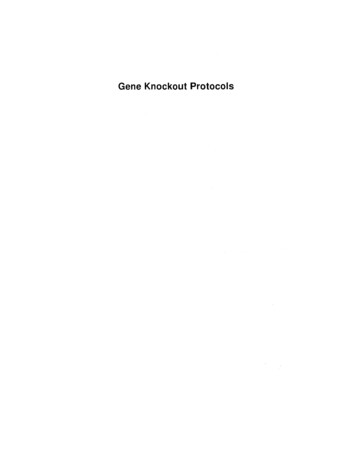
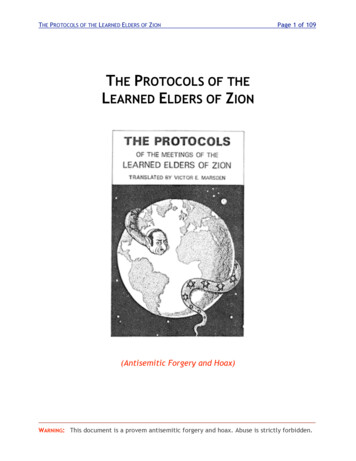

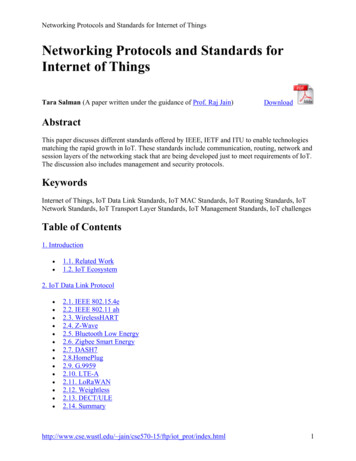

![01. Communication Protocols [Read-Only] - GE Grid Solutions](/img/55/commprot.jpg)
